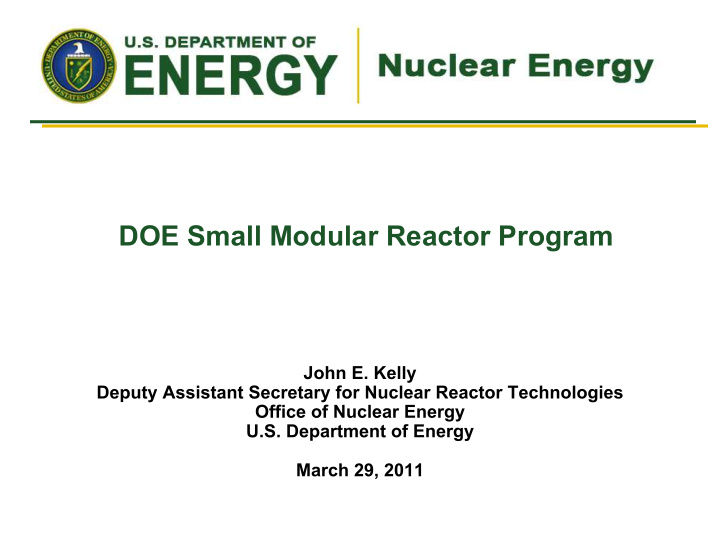



DOE Small Modular Reactor Program John E. Kelly Deputy Assistant Secretary for Nuclear Reactor Technologies Office of Nuclear Energy U.S. Department of Energy March 29, 2011
Domestic SMR Interest Value Proposition – Enhanced safety and security – Reduced capital cost makes nuclear energy feasible for more utilities – Shorter construction schedules due to modular construction – Improved quality due to replication in factory-setting – Meets electric demand growth incrementally Potential Markets – Replacement/repowering aging or costly fossil plants – Air cooling, reduced water usage & reduced BOP acreage expands potential siting options – Non-electrical (process heat/desalination) customers – Co-location with industrial and district heating applications – International markets 2
Capital Cost Barrier for Large Plants Market Capitalization Too Low “Typical” nuclear company: – $13 B per year revenues – $13 B outstanding debt – $40 B assets – $17 B market capitalization Large nuclear power plant a difficult challenge (~$10 B) Moody’s 2009: – “We view new nuclear generation plants as a ‘bet the farm’ endeavor for most companies, due to the size of the investment and length of time needed to build a nuclear power facility.” – Utilities should consider partnering with larger energy companies 3
Coal Plant Replacement SMR Σ = 120 GW(e) 4
“Complexity” Versus “Simplicity” On-site Construction – “Complexity” Transport SMR to Site “Simplicity” 5
Potential for Learning Navy industrial experience part of SMR business case – Assembly line replication optimizes cost, schedule, and quality through greater standardization of components and processes – Analysis of shipbuilding validates “ nth” of a kind optimization – Increased skilled workforce retention with order backlog and diverse jobs – Economic learning through replication 6
Small Modular Reactors Near-Term LWR Designs Well Understood Technology – LWR based designs – Standard <5% UO2 fuel – Regulatory & operating experience – Deployment in10 years (2020) Westinghouse Longer-Term SMRs New Innovative Technologies – Mostly non-LWR based designs – Deployment 15-20 years Broader Applications – Process heat applications – Transportable/mobile – Long-lived cores GE PRISM Hyperion 7
Office of Advanced Reactor Concepts Small Modular Reactor Program DOE Small Modular Reactor Program – Enable the deployment of a fleet of SMRs in the United States – SMR Program is a new start program for FY 2011 – Structured to address the need to accelerate the deployment of mature SMR designs based on LWR technology – Conduct needed R&D activities to advance the understanding and demonstration of innovative reactor technologies and concepts SMR Program Elements: – LWR SMR Licensing Technical Support ($450M/5-year program) Industry partnerships for cost-sharing design certification & licensing activities – SMR Advanced Concepts RD&D (~ $35M/per year) Conduct R&D on innovative technologies/systems/components and support generic licensing work Support nuclear codes & standards development activities Collaborate with NRC on SMR licensing framework to support SMR commercialization 8
TVA/Oak Ridge Business Model USG as First Users 34 MW Projected 2020 24 MW Electricity Demand: 1.3 M MWhr ~ 170 MW 20 MW 9
Innovation and Competitiveness “This is our generation’s Sputnik moment. … We’ll invest in biomedical research, information technology, and especially clean energy technology -– an investment that will strengthen our security, protect our planet, and create countless new jobs for our people. ” “So tonight, I challenge you to join me in setting a new goal: By 2035, 80 percent of America’s electricity will come from clean energy sources. Some folks want wind and solar. Others want nuclear, clean coal and natural gas. To meet this goal, we will need them all…” President Barack Obama State of the Union Address January 25 th , 2011 10
Recommend
More recommend